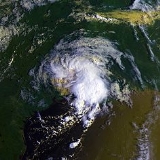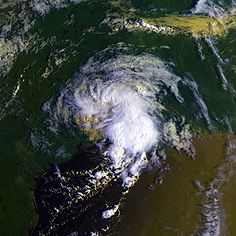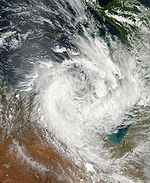
List of unnamed tropical cyclones
Encyclopedia
The list of unnamed tropical cyclones since naming began includes all tropical cyclones that met the criteria for naming
in a basin, but that for whatever reason, did not receive a name. These systems have occurred in all basins and for various reasons.
or Tropical Cyclone Warning Center, it has reached tropical storm status. A tropical cyclone with winds of tropical storm intensity or higher goes unnamed when operationally, it is not considered to have met the criteria for naming. Reasons for this include:
 Naming has been used since the 1950 season
Naming has been used since the 1950 season
.
 Naming began in 1960. Before 1957, a few systems in the central Pacific basin
Naming began in 1960. Before 1957, a few systems in the central Pacific basin
were given names, generally in an ad hoc manner.
and the Joint Typhoon Warning Center
, a system will sometimes be considered a tropical storm by the JTWC but only a depression by the JMA. This results in several apparent unnamed systems. Because the JMA is responsible for naming, "unnamed tropical cyclones" that met the JTWC's tropical storm criteria but not those of the JMA are excluded.
and the Joint Typhoon Warning Center
, a system will sometimes be considered a tropical storm by the JTWC but only a depression by the IMD. This results in several apparent unnamed systems. Because the IMD is responsible for naming, "unnamed tropical cyclones" that met the JTWC's tropical storm criteria but not those of the IMD are excluded.
Naming has taken place since mid-2003.
There have been no unnamed tropical cyclones using the India Meteorological Department's criteria. One system, 2007's Yemyin, was upgraded after the fact and retroactively named.
.

Tropical cyclone naming
Tropical cyclones have officially been named since 1945 and are named for a variety of reasons, which include to facilitate communications between forecasters and the public when forecasts, watches, and warnings are issued. Names also reduce confusion about what storm is being described, as more...
in a basin, but that for whatever reason, did not receive a name. These systems have occurred in all basins and for various reasons.
Scope, reasons, and naming overview
In order to ease communications and advisories, tropical cyclones are named when, according to the appropriate Regional Specialized Meteorological CenterRegional Specialized Meteorological Center
A Regional Specialized Meteorological Centre is responsible for the distribution of information, advisories, and warnings regarding the specific program they have a part of, agreed by consensus at the World Meteorological Organization as part of the World Weather Watch.-Tropical...
or Tropical Cyclone Warning Center, it has reached tropical storm status. A tropical cyclone with winds of tropical storm intensity or higher goes unnamed when operationally, it is not considered to have met the criteria for naming. Reasons for this include:
- Post-operational upgrading. An example of this is the Unnamed tropical storm from the 1996 Pacific hurricane season1996 Pacific hurricane seasonThe 1996 Pacific hurricane season was an event in tropical cyclone formation and the third least active Pacific hurricane season in recorded history, behind 1977 and 2010. It officially began May 15, 1996 in the eastern north Pacific and on June 1, 1996 in the central north Pacific. It ended on...
. - Being missed during a season. An example of this is the 2005 Azores Subtropical storm2005 Azores subtropical stormThe 2005 Azores subtropical storm was the nineteenth nameable storm of the record-breaking 2005 Atlantic hurricane season. It was not officially named by the National Hurricane Center as it was operationally classified as a non-tropical low. The storm developed in the eastern Atlantic Ocean out of...
from the 2005 Atlantic hurricane season2005 Atlantic hurricane seasonThe 2005 Atlantic hurricane season was the most active Atlantic hurricane season in recorded history, repeatedly shattering numerous records. The impact of the season was widespread and ruinous with an estimated 3,913 deaths and record damage of about $159.2 billion...
.
North Atlantic Ocean

1950 Atlantic hurricane season
The 1950 Atlantic hurricane season was the first year in which tropical cyclones were given official names in the Atlantic basin. Names were taken from the Joint Army/Navy Phonetic Alphabet, with the first named storm being designated "Able", the second "Baker", and so on. It was an active season...
.
- Tropical Storm 12 – 1950
- Tropical Storm 1 – 19521952 Groundhog Day Tropical StormThe 1952 Groundhog Day Storm was the only Atlantic tropical cyclone on record in the month of February. First observed in the western Caribbean Sea on February 2, it moved rapidly throughout its duration and struck southwestern Florida within 24 hours of forming. In the state, the winds...
- Tropical Storm 3 – 1953
- Tropical Storm 7 – 1953
- Tropical Storm 10 – 1953
- Tropical Storm 11 – 1953
- Tropical Storm 13 – 1953
- Tropical Storm 14 – 1953
- Hurricane 8 – 1954
- Tropical Storm 10 – 1954
- Tropical Storm 5 – 1955
- Tropical Storm 11 – 1955
- Tropical Storm 1 – 1956
- Tropical Storm 1 – 1957
- Tropical Storm 8 – 1957
- Hurricane 3 – 19591959 Escuminac HurricaneThe Escuminac Hurricane is the name given for a rare June hurricane which struck Canada's Gulf of St. Lawrence on the night of June 19 during the 1959 Atlantic hurricane season, sinking 22 fishing boats from the port of Escuminac, New Brunswick, Canada, and drowning 35.-Meteorological history:A...
- Tropical Storm 1 – 1960
- Tropical Storm 6 – 1961
- Tropical Storm 3 – 1963
- Tropical Storm 1 – 1964
- Tropical Storm 2 – 1964
- Tropical Storm 12 – 1964
- Tropical Storm 1 – 1965
- Hurricane 10 – 1969
- Tropical Storm 11 – 1969
- Tropical Storm 16 – 1969
- Hurricane 17 – 1969
- Tropical Storm 4 – 1970
- Hurricane 9 – 19701970 Canada hurricaneThe 1970 Canada hurricane was a unnamed tropical cyclone that struck Newfoundland in October 1970. The fourth hurricane and eighth nameable storm of the 1970 Atlantic hurricane season, this system developed northeast of the Bahamas as a subtropical depression on October 12. On the following day,...
- Hurricane 10 – 1970
- Hurricane 2 – 1971
- Tropical Storm 1 – 1987
- Tropical Storm 6 – 1988
- Hurricane 8 – 1991
- Tropical Storm 2 – 2006Unnamed Tropical Storm (2006)The 2006 Nova Scotia tropical storm was a short-lived tropical cyclone that was unnamed operationally during the season but was recognized during post-season analysis and designated AL022006...
Subtropical cyclones
Only unnamed subtropical cyclones that could have been named are included. This excludes several that existed, but that were unnamed because subtropical cyclones were not named when they existed.- Subtropical Storm 19 – 20052005 Azores subtropical stormThe 2005 Azores subtropical storm was the nineteenth nameable storm of the record-breaking 2005 Atlantic hurricane season. It was not officially named by the National Hurricane Center as it was operationally classified as a non-tropical low. The storm developed in the eastern Atlantic Ocean out of...
Eastern and central north Pacific Ocean

Tropical cyclone basins
Traditionally, areas of tropical cyclone formation are divided into seven basins. These include the north Atlantic Ocean, the eastern and western parts of the northern Pacific Ocean, the southwestern Pacific, the southwestern and southeastern Indian Oceans, and the northern Indian Ocean. The...
were given names, generally in an ad hoc manner.
- Tropical Storm 4 – 1962
- Tropical Storm 8 – 1962
- Tropical Storm 4 – 1963
- Hurricane 12 – 1975
- Tropical Storm 1 – 1996
- Subtropical Storm 5 – 20062006 Central Pacific cycloneThe 2006 Central Pacific cyclone, also called 91C.INVEST or Storm 91C, was an unusual weather event of 2006. Forming on October 30 from a mid-latitude cyclone in the north Pacific mid-latitudes, it moved over waters warmer-than-normal. It acquired some features more typical of subtropical or even...
*unofficial*
Western north Pacific Ocean
Due to differences in wind speed criteria between the Japan Meteorological AgencyJapan Meteorological Agency
The or JMA, is the Japanese government's weather service. Charged with gathering and reporting weather data and forecasts in Japan, it is a semi-autonomous part of the Ministry of Land, Infrastructure and Transport...
and the Joint Typhoon Warning Center
Joint Typhoon Warning Center
The Joint Typhoon Warning Center is a joint United States Navy – United States Air Force task force located at the Naval Maritime Forecast Center in Pearl Harbor, Hawaii...
, a system will sometimes be considered a tropical storm by the JTWC but only a depression by the JMA. This results in several apparent unnamed systems. Because the JMA is responsible for naming, "unnamed tropical cyclones" that met the JTWC's tropical storm criteria but not those of the JMA are excluded.
- Tropical Storm 1 - 1957
- Tropical Storm 8 - 1957
- Tropical Storm 9 - 1957
- Tropical Storm 17 - 1957
- Tropical Storm 33 - 1965
- Tropical Storm 9 - 1986
- Tropical Storm 15 - 1986
- Tropical Storm 6 – 1995
- Tropical Storm 17 – 1996
North Indian Ocean
Due to differences in wind speed criteria between the India Meteorological DepartmentIndia Meteorological Department
The India Meteorological Department , also referred to as the Met Office, is an agency of the Ministry of Earth Sciences of the Government of India. It is the principal agency responsible for meteorological observations, weather forecasting and seismology...
and the Joint Typhoon Warning Center
Joint Typhoon Warning Center
The Joint Typhoon Warning Center is a joint United States Navy – United States Air Force task force located at the Naval Maritime Forecast Center in Pearl Harbor, Hawaii...
, a system will sometimes be considered a tropical storm by the JTWC but only a depression by the IMD. This results in several apparent unnamed systems. Because the IMD is responsible for naming, "unnamed tropical cyclones" that met the JTWC's tropical storm criteria but not those of the IMD are excluded.
Naming has taken place since mid-2003.
There have been no unnamed tropical cyclones using the India Meteorological Department's criteria. One system, 2007's Yemyin, was upgraded after the fact and retroactively named.
South-west Indian Ocean
Tropical Cyclones have been named within this basin since 1960, with any tropical depression or Subtropical depression that RSMC La Reunion analyze as having 10-minute sustained windspeeds of at least 65 km/h, 40 mph is named. However unlike other basins RSMC La Reunion do not name tropical depressions, however as they delegate the rights to name tropical cyclones to the Subregional tropical cyclone warning centers in Mauritius or Madagascar depending on whether it is east or west of the 55th meridian east55th meridian east
The meridian 55° east of Greenwich is a line of longitude that extends from the North Pole across the Arctic Ocean, Europe, Asia, the Indian Ocean, the Southern Ocean, and Antarctica to the South Pole....
.
- Moderate Tropical Storm F1 – 1998–99
- Subtropical Depression 13 – 1999-00
- Subtropical Depression 15 – 2000–01
- Subtropical Storm 15 – 2006–07
- Tropical Cyclone 01U – 2007–08
- Subtropical Storm 10 – 2009–10
- Subtropical Depression 9 – 2010–11
Australian region

- Cyclone 5 – 1964–65Pre-1970 Southern Hemisphere tropical cyclone seasonsThe Pre-1970 Southern Hemisphere tropical cyclone seasons ran year-round from July 1 to June 30, reaching their peaks mid-February to early March.Pre-1970 1970–75 1975–80 1980–1985-Unnnamed tropical cyclone :The Banda Islands were hit in March...
- Cyclone 6 – 1964–65Pre-1970 Southern Hemisphere tropical cyclone seasonsThe Pre-1970 Southern Hemisphere tropical cyclone seasons ran year-round from July 1 to June 30, reaching their peaks mid-February to early March.Pre-1970 1970–75 1975–80 1980–1985-Unnnamed tropical cyclone :The Banda Islands were hit in March...
- Cyclone 6 – 1965–66Pre-1970 Southern Hemisphere tropical cyclone seasonsThe Pre-1970 Southern Hemisphere tropical cyclone seasons ran year-round from July 1 to June 30, reaching their peaks mid-February to early March.Pre-1970 1970–75 1975–80 1980–1985-Unnnamed tropical cyclone :The Banda Islands were hit in March...
- Cyclone 9 – 1965–66Pre-1970 Southern Hemisphere tropical cyclone seasonsThe Pre-1970 Southern Hemisphere tropical cyclone seasons ran year-round from July 1 to June 30, reaching their peaks mid-February to early March.Pre-1970 1970–75 1975–80 1980–1985-Unnnamed tropical cyclone :The Banda Islands were hit in March...
- Cyclone 2 – 1967–68Pre-1970 Southern Hemisphere tropical cyclone seasonsThe Pre-1970 Southern Hemisphere tropical cyclone seasons ran year-round from July 1 to June 30, reaching their peaks mid-February to early March.Pre-1970 1970–75 1975–80 1980–1985-Unnnamed tropical cyclone :The Banda Islands were hit in March...
- Cyclone 3 – 1967–68Pre-1970 Southern Hemisphere tropical cyclone seasonsThe Pre-1970 Southern Hemisphere tropical cyclone seasons ran year-round from July 1 to June 30, reaching their peaks mid-February to early March.Pre-1970 1970–75 1975–80 1980–1985-Unnnamed tropical cyclone :The Banda Islands were hit in March...
- Cyclone 11 – 1967–68Pre-1970 Southern Hemisphere tropical cyclone seasonsThe Pre-1970 Southern Hemisphere tropical cyclone seasons ran year-round from July 1 to June 30, reaching their peaks mid-February to early March.Pre-1970 1970–75 1975–80 1980–1985-Unnnamed tropical cyclone :The Banda Islands were hit in March...
- Cyclone 13 – 1967–68Pre-1970 Southern Hemisphere tropical cyclone seasonsThe Pre-1970 Southern Hemisphere tropical cyclone seasons ran year-round from July 1 to June 30, reaching their peaks mid-February to early March.Pre-1970 1970–75 1975–80 1980–1985-Unnnamed tropical cyclone :The Banda Islands were hit in March...
- Cyclone 17 – 1967–68Pre-1970 Southern Hemisphere tropical cyclone seasonsThe Pre-1970 Southern Hemisphere tropical cyclone seasons ran year-round from July 1 to June 30, reaching their peaks mid-February to early March.Pre-1970 1970–75 1975–80 1980–1985-Unnnamed tropical cyclone :The Banda Islands were hit in March...
- Cyclone 15 – 1968–69Pre-1970 Southern Hemisphere tropical cyclone seasonsThe Pre-1970 Southern Hemisphere tropical cyclone seasons ran year-round from July 1 to June 30, reaching their peaks mid-February to early March.Pre-1970 1970–75 1975–80 1980–1985-Unnnamed tropical cyclone :The Banda Islands were hit in March...
- Cyclone 16 – 1968–69Pre-1970 Southern Hemisphere tropical cyclone seasonsThe Pre-1970 Southern Hemisphere tropical cyclone seasons ran year-round from July 1 to June 30, reaching their peaks mid-February to early March.Pre-1970 1970–75 1975–80 1980–1985-Unnnamed tropical cyclone :The Banda Islands were hit in March...
- Cyclone 1 – 1969–70Pre-1970 Southern Hemisphere tropical cyclone seasonsThe Pre-1970 Southern Hemisphere tropical cyclone seasons ran year-round from July 1 to June 30, reaching their peaks mid-February to early March.Pre-1970 1970–75 1975–80 1980–1985-Unnnamed tropical cyclone :The Banda Islands were hit in March...
- Cyclone 7 – 1969–70Pre-1970 Southern Hemisphere tropical cyclone seasonsThe Pre-1970 Southern Hemisphere tropical cyclone seasons ran year-round from July 1 to June 30, reaching their peaks mid-February to early March.Pre-1970 1970–75 1975–80 1980–1985-Unnnamed tropical cyclone :The Banda Islands were hit in March...
- Unrecorded Cyclone
- Cyclone 2 – 1981–82
- Cyclone 6 – 1983–84
- Cyclone 8 – 1995–96
- Cyclone 1 – 2002–03
- Tropical Cyclone 01U – 2007–08
South Pacific
- Unnamed Tropical Cyclone 1971–72 – December 1971
- Unnamed Tropical Cyclone 1971–72 – January 1972
- Unnamed Tropical Cyclone 1973–74 – November 1973
- Unnamed Tropical Cyclone 1976–77 – February 1977 (1)
- Unnamed Tropical Cyclone 1976–77 – February 1977 (2)
- Unnamed Tropical Cyclone 1980–81 – February 1981
- Unnamed Tropical Cyclone 1980–81 – February/March 1981
- Unnamed Tropical Cyclone 1980–81 – March 1981
- Unnamed Tropical Cyclone 1983–84 – February 1984
- Unnamed Tropical Cyclone 1983–84 – March 1984
- Unnamed Tropical Cyclone 1984–85 – December 1985
- Unnamed Tropical Cyclone 1986–87 – March 1987
- Unnamed Tropical Cyclone 1988–89 – February 1989
- Unnamed tropical cyclone 1990–91 – December 1990
- Tropical Cyclone 29P 1996–97 – February 1997

